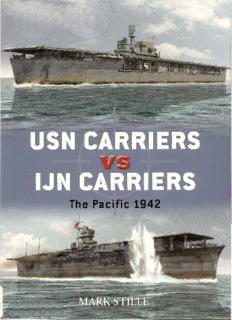
USN Carriers vs IJN Carriers: The Pacific, 1942 (Osprey Duel 6) PDF
Preview USN Carriers vs IJN Carriers: The Pacific, 1942 (Osprey Duel 6)
ABOUT THE AUTHOR AND ILLUSTRATORS COMMANDER [RH) MARKSTILLEserved asaNaval IntelligenceOfficer,spending overfive years ofhisnaval careerassignedtovarious USNavy carriers. He continuestoworkinthisfield inacivilian capacity. Heholds an MAfrom the NavalWarCollegeand hashad severalwargamespublished. He livesin Virginia,USA. IAN PALMER isahighlyexperienceddigital artist.Agraduate in 3Ddesign, hecurrentlyworks asaseniorartistfortheworld'slargestgamesdeveloper. Besideshisartisticinterestshe isalsoakeen musicianand motorcyclist.He livesinSurreywith hiswife andtwocats. HOWARDGERRARDstudied attheWallasey School ofArt and has beena freelance designerand illustratorforover20 years. Heisan associate memberof theGuildofAviationArtists and haswonboththeSocietyofBritishAerospace CompaniesAward andtheWilkinsonSwordTrophy. Howardcompletedthe battlesceneillustrationinthisbook. MARK STILLE FirstpublishedinGreatBritainin2007byOspreyPublishing, MidlandHouse,WestWay,Botley,Oxford0X2OPH,UK 443ParkAvenueSouth,NewYork,NY10016,USA E-mail:[email protected] ©2007OspreyPublishingLtd. Dedication Allrightsreserved.Apartfromanyfairdealingforthepurposeofprivatestudy,research, ThebookisdedicatedroLoisKaewackiwholovedhistory. criticismorreview,aspermittedundertheCopyright,DesignsandPatentsAct,1988,nopart ofthispublicationmaybereproduced,storedinaretrievalsystem,ortransmittedinanyform Author'snote orbyanymeans,electronic.electrical,chemical,mechanical,optical,photocopying,recording TheauthorisindebtedtothestaffsoftheUSNaval orotherwise,withoutthepriorwrittenpermissionofthecopyrightowner.Enquiriesshould HistoricalCenterPhotographicSectionandtheKure beaddressedtothePublishers. MaritimeMuseumfortheirassistanceinprocuring thephotographsusedinthistitle. ACIPcataloguerecordforthisbookisavailablefromtheBritishLibrary ISBN:978I846032486 Thepersonalaccountsweretakenfromthefollowingfour sources: PagelayoutbyMyriamBell Astor,Gerald, Wingsa/Gold,PresidioPress,NY(2004) IndexbyGlynSutcliffe MasatakeOkimiyaandJiroHirikoshi,Zero,Ballantine TypesetinITCConduitandAdobeGaramond Books,NY(1979) MapsbyBoundford.com,Huntingdon.UK MitsuoFuchidaandMasatakeOkumiya,Midway, BattlescenepaintingbyHowardGertard NavallnstitutePtess,Annapolis,Maryland(1986) DigitalarewotkbyIanPalmer Wooldrige,E.T.(ed.),CarrierWarfareinthePacific, SmithsonianInstitutionPress,Washington,DC(1993) OriginatedbyPDQDigitalMediaSolutions PrintedinChinathroughBookbuilders Artist'snote 08 09 10 11 12 II 10 9 8 7 6 5 4 3 Readersmaycaretonotethattheoriginalpaintingfrom ForacatalogueofallbookspublishedbyOspreyMilitaryandAviationpleasecontact: whichthebattlescenecolourplateinthisbookwas preparedisavailableforprivatesale.Allreproduction NORTHAMERICA copyrightwhatsoeverisrerainedbythePublishers. OspreyDirect,cloRandomHouseDistributionCenter,400HahnRoad, Allenquiriesshouldbeaddressedto: Westminster,MD21157 HowardGerrard E-mail:[email protected] IIOaksRoad Tenterden ALLOTHERREGIONS Kent OspreyDirectUK,P.O.Box140Wellingborough,Northants,NN82FA,UK TN306RD E-mail:[email protected] ThePublishersregretthattheycanenterintono www.ospreypublishing.com correspondenceuponthismatter.. CONTENTS Introduction 4 Chronology 6 Design and Development 8 The Strategic Situation 19 Technical Specifications 23 The Combatants 41 Combat 53 Statistics and Analysis 72 Aftermath 77 Further Reading 79 Index 80 INTRODUCTION. ThePacificWar berween theAmerican andJapanese navies is nowremembered as a carrierwar. However, at the onset ofthewar, both navies expected that the conflict wouldbedecidedbyagiganticclashofbattleshipssomewhereinthewestern Pacific. Whilebothnationshadbeenoperatingcarrierssincetheearly1920s,itwasenvisioned thatcarrierswouldsimplyplaysupportingroles to the battle fleets. On thefirst dayofthewar, December7, 1941, this assumptionwas proved to be incorrect. The war opened with astartling display ofthe power ofcarrier-launched aircraft, provingbeyondadoubt thatthebattleshiphad beeneclipsed bytheaircraft carrier.TheJapaneseattackonPearlHarbor, homeoftheUnitedStatesNavyPacific Fleet, served notice that the carrierwould be the principal naval striking power of thewar. At Pearl Harbor, the ImperialJapanese Navy (IJN) massed six fleet aircraft carriers into a single force, embarking over 400 aircraft. Achieving strategic and tactical surprise, theJapanese devastated the Pacific Fleet's battle line. Ofthe eight US battleships present, five were sunk and the others damaged. Fortunatelyfor the Americans, theprimarytargetoftheJapaneseattack, the PacificFleet's three aircraft carriers,was not present at Pearl Harbor that day. After Pearl Harbor, the US Navy was forced to abandon its prewar plans and instead centered its operations on its remaining carriers. Ironically, the IJN, havingjust demonstrated the striking power and range ofthe carrier, stillclungto the notion that thewarwouldstill be decided byaclashofdreadnoughts. During the first part ofthe war, Japanese expansion was rapid, underpinned by the six fleet carriers ofthe FirstAir Fleet. The US possessions ofWake and Guam islandswerequicklycaptured,whileoperationsinthePhilippinesforcedtheAmerican andFilipinogarrison tosurrenderinMay1942.TheFirstAirFleetwasusedto cover 4 the invasion ofRabaul on NewBritain IslandinJanuary 1942as well as the Dutch EastIndiesinFebruary.WherevertheFirstAirFleetwasemployed, thecombination TheKidoButoiduringthe ofmassed air power and the excellence ofits aircraft and aircrew quickly crushed IndianOceanoperationof April1942.Thisphotoclearly Allied resistance. This string ofsuccesses continued through April 1942, when five showsthepowerofthis carriersoftheFirstAir Fleetmoved into theIndianOceanto devastate Britishnaval formation.Akogiisleadingthe fotces andshipping. columnthatincludes,inorder, As the IJN's carrier force continued its rampage across the Pacific and Indian Soryu,Hiryu,allfourKongo oceans, the US Navy's carriers began tentative'offensive raids againstJapanese-held classbattleships,andthetwo Shokakuclasscarriers.This islands.Theseraidswereconductedbysinglecarriersandtargetedislandbaseswithout wastheonlytimeinthewar heavydefenses,Japaneselosseswerelight, buttheexperiencegainedbytheAmericans whenallfourKongo-class provedinvaluable. InApril 1942, the US Navyconductedatwo-~arrier taid against unitsoperatedwiththeKido the Japanese homeland using medium-range bombers. Despite the intense activity Butai.[KureMaritime Museum] ofbothsides' carriers, no carrierclashhadyet occurred. However, in May 1942 this would change, and before the year was out, American andJapanese carrier forces wouldengageinfourdifferentactions.AttheseepicbattlesoftheCoralSea,Midway, the EasternSolomons, andSantaCruz, bothsidessufferedheavylosses, butthe end resultwasunmistakable.Japaneseexpansionwasstopped,andtheUSNavyhadtaken itsfirststepson the road toTokyo. 5 DES'IGN AND DEVELOPMENT US NAVY CARRIER DOCTRINE FollowingWorld War I, during which the British Royal Navy had demonstrated the utilityofembarking aircraft on ships, includingaircraft carriers, the US Navy realized that naval aviation was an instrumental part ofmodern naval operations. Fearful offalling farther behind the British, the US Navy receivedfunding for the conversionofacollierintoanaircraftcarrierinJuly 1919.Thisexperimentalcarrier wasfollowed bythefirstfleetcarriersin 1927. Uponfirstenteringservice,USNavy carriers' primarytaskwas tosupportthe battlefleet. Carrieraircraftwouldprovide reconnaissance andspotting for the battle fleet while denying those advantages to the enemy. Spotting was viewed as especially important as aircraft could observe the fall offire and radio corrections. Carriers were also expected to protect the airspaceovertheirown fleet, thus denying the enemytheadvantagesoflong-range spottingandscouting. Gradually, theUS Navydevelopedthecarrier'sroleintoanindependentoffensive platform. Early carrier aircraft were unable to carry torpedoes large enough to crippleorsinkacapitalship, and although bombscould be carried, theyposed no real threat to ships maneuvering at speed to avoid attack. However, in the 1920s, the offensivecapabilityofcarrieraircraftwas greatlyincreased by the development 8 ofdive-bombing, whichfor the first time, allowed maneuveringships to bestruck
Description: